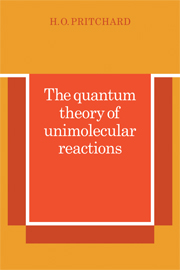Book contents
- Frontmatter
- Contents
- Preface
- Acknowledgements
- 1 The observed properties of thermal unimolecular reactions
- 2 The master equation for internal relaxation in molecules
- 3 Reaction as a perturbation of the internal relaxation
- 4 The specific rate function k(E) as an inverse Laplace transform
- 5 Unimolecular fall-off in strong collision systems
- 6 A molecular dynamic approach to specific rate functions
- 7 Building in the randomisation processes
- 8 Weak collision processes
- 9 How well does it all work?
- Appendix 1 Units, symbols, and errata
- Appendix 2 Rate constants for the thermal isomerisation of cyclopropane and for the thermal decomposition of cyclobutane
- Appendix 3 Computer programs for thermal unimolecular reactions
- Exercises
- References
- Author index
- Subject index
- Frontmatter
- Contents
- Preface
- Acknowledgements
- 1 The observed properties of thermal unimolecular reactions
- 2 The master equation for internal relaxation in molecules
- 3 Reaction as a perturbation of the internal relaxation
- 4 The specific rate function k(E) as an inverse Laplace transform
- 5 Unimolecular fall-off in strong collision systems
- 6 A molecular dynamic approach to specific rate functions
- 7 Building in the randomisation processes
- 8 Weak collision processes
- 9 How well does it all work?
- Appendix 1 Units, symbols, and errata
- Appendix 2 Rate constants for the thermal isomerisation of cyclopropane and for the thermal decomposition of cyclobutane
- Appendix 3 Computer programs for thermal unimolecular reactions
- Exercises
- References
- Author index
- Subject index
Summary
Since the work described in this monograph has evolved separately from the mainstream of research on the theory of unimolecular reactions during the past 25 years, a short personal history, summarising the evolution of my thoughts, would seem to be appropriate. When I became a research student in 1948, Michael Polanyi had just resigned from the Chair of Physical Chemistry in the University of Manchester, and M. G. Evans was about to take his place. M.G. arrived permanently in Manchester the following Spring, and he began to build one of the most remarkable schools of physical chemistry that has ever existed: his brother, A.G., together with Ernest Warhurst, Michael Swarcz, H. A. Skinner, and P. H. Plesch, were already there, and J. H. Baxendale returned from Leeds with him. In no time at all, the assembly had grown to include H. C. Longuet-Higgins, W. C. E. Higginson, J. S. Rowlinson, K. E. Russell, A. F. Trotman-Dickenson and Norbert Uri, and, for a while, Michael Kasha. All of these people worked within the ambit of M.G.'s wide range of interests, and the fame of the department spread like wildfire: so much so, in fact, that it was at times almost impossible to get on with one's research for describing it to visitors, who not only included physical chemists and scientists of other persuasions, but civic dignitaries as well! With contagious enthusiasm, M.G. initiated a concerted onslaught on the problem of energy transfer in chemical reactions, with a longer-term goal of understanding the nature of primary photochemical processes.
- Type
- Chapter
- Information
- The Quantum Theory of Unimolecular Reactions , pp. ix - xivPublisher: Cambridge University PressPrint publication year: 1984

